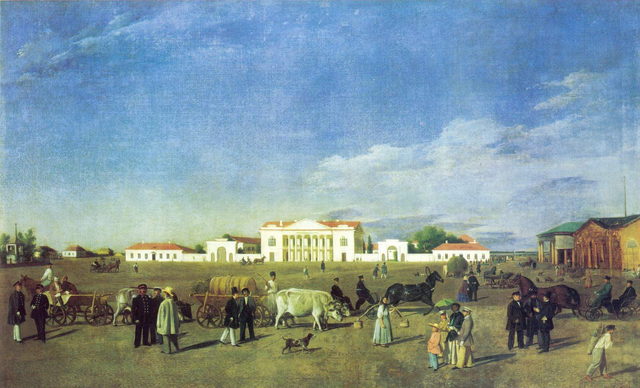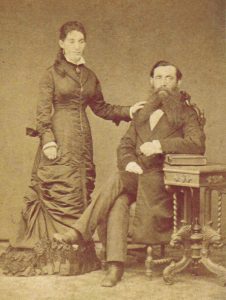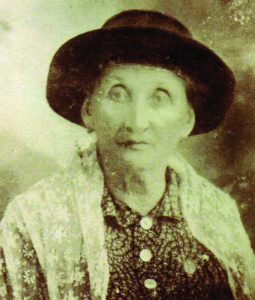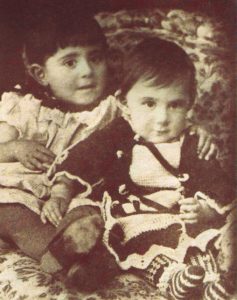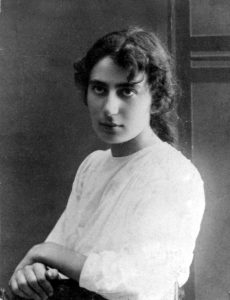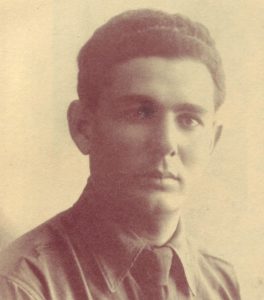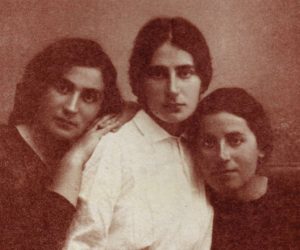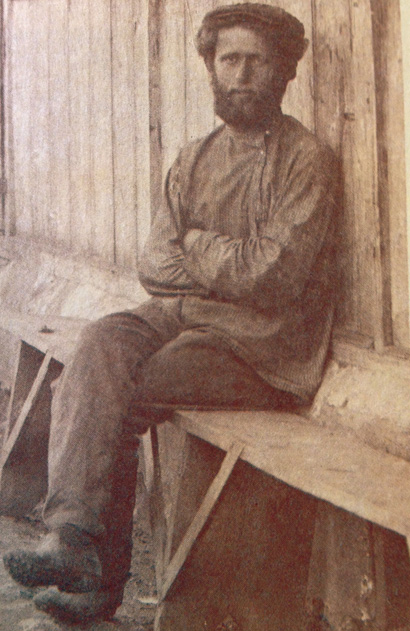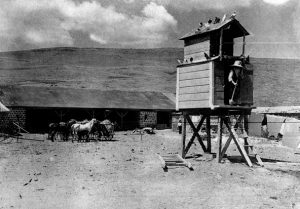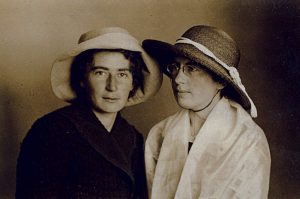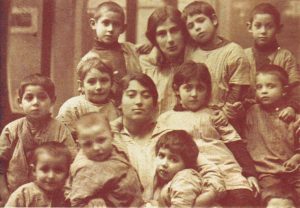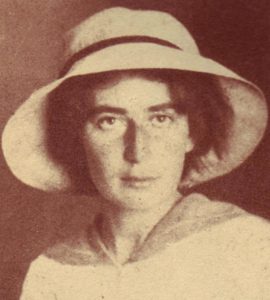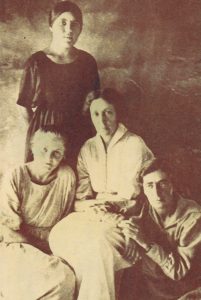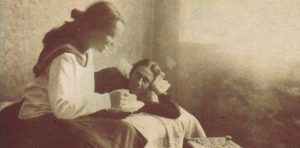Movers and Shakers
The cemetery by Kinneret Village, on the Sea of Galilee, is one of Israel’s loveliest historic sites. The peaks of the Golan Heights twinkle on the horizon, seemingly just beyond reach.
Among the orderly paths and well-trimmed foliage, some of Labor Zionism’s greatest leaders lie forever at rest, their presence silent but imposing. Their predecessors who died abroad – Moses Hess, Dov Ber Borochov, and Nahman Syrkin – are buried here not far from such local heroes as Berl Katznelson, Saul Avigur, and Samuel Yavnieli.
Alexander Square is the center of Poltova, the city where Rahel grew up. Evgraf Fedorovich Krendovsky, oil on canvas, circa 1830
Between the headstones of poet Elisheva Bihovsky and the relatively new monument to Naomi Shemer, a wistful melody wafts through the air. Is the music bewitched? Is it just an echo of the Sea of Galilee’s gentle ripples on the shore, or the whisper of a lost soul?
Soon the hidden loudspeaker becomes evident, but the enchantment surrounding Rahel the poetess’ grave remains, as if she herself were still wondering:
Was it I who bathed in the innocent
blue / Under a peaceful sky / Of my Galilee, my own Galilee? / Was it all a dream? Was it I? (Ra’hel, Flowers of Perhaps [Toby Press, 2008], p. 47)
Rahel (Ra’aya) Bluwstein was born in September 1890, during the Sukkot festival, in the town of Saratov, Russia. Her father, Isser Leib, had been conscripted into the czar’s army as a child, but unlike the vast majority of his peers, he’d clung to his Jewish faith and observance. Released from the armed forces after ten years of “re-education” and twenty-five of service, he was blessed with the rare privilege of residing outside the Pale of Jewish Settlement, anywhere in Russia. He dealt in real estate, furs, gold, and diamonds, and at one point even owned a cinema.
After his first wife died, leaving him with four children, Isser Leib married Sonia Mandelstam, the branches of whose large, well-connected family included rabbinic, Enlightenment, and Zionist orientations.
Sonia’s father was the rabbi of Riga, Latvia, and later of a community in Kiev. Her brother, eye doctor Max Emanuel Mandelstam, was the first Jewish medical student to qualify in Russia. President of the fifth Zionist Congress, Mandelstam was a founding member of the territorial movement investigating a temporary Jewish homeland outside of Zion, such as in Uganda. Writer Ossip Mandelstam, executed for opposing Stalin regime, was one of the family’s Hebrew authors, and there were artists, scientists, and lawyers as well.
The Bluwstein home was thus steeped in Jewish tradition but also profoundly Zionist and highly cultured.
Rahel was the seventh of Sonia’s eight children and the eleventh in the household. Shortly after her birth, the family moved to Poltava, birthplace of such leading socialist Zionists as Dov Ber Borochov and Yitzhak Ben-Zvi. Some of the Bluwstein children actually studied with Moshe Borochov, father of the founder of Labor Zionism, and Ben-Zvi’s family of origin, the Shimshis, ranked among their close friends.
As a child, Rahel learned only enough Hebrew to read the prayer book. Like her sisters, she was artistic. She wrote Russian poetry from a young age but seemed more gifted at drawing, dreaming of becoming a painter.
Eastward!
Though Rahel and her sister Shoshana belonged to the local Zionist youth movement from their early teens, their parents disapproved of girls’ wandering around a town seething with revolutionary fervor. They soon left home for good, however, after their mother died in 1906, and their father married Masha Naumovna, whom Rahel experienced as a wicked stepmother distancing her husband from his children. Many years later, wasting away in the land of Israel, Rahel felt that her stepmother abused her control of the late Isser Leib’s fortune to deny his daughter medical care.
Rahel and Shoshana moved to Kiev to live with their elder sister Liza and attend college. The two girls resolved that, after university in western Europe, they’d settle in the land of Israel. In 1909, however, before embarking on their studies, they joined many other young Europeans on an “Oriental tour,” sailing from Odessa to Ottoman Palestine.
Their arrival in Zion changed their plans. As their ship anchored in Jaffa’s picturesque harbor after a fortnight at sea, the sisters raised their right hands, burst into the Zionist anthem, Ha-tikva, and swore – only half-jokingly – never to leave their homeland.
Rahel was one of many well-known figures coming home on the SS Ruslan, sometimes called the Zionist Mayflower. The Ruslan, docked in Constantinople, 1919
Their first encounter with the Levant was far from pleasant, however, as Arab porters descended on them, competing for pennies by ferrying the young women on crowded boats from ship to shore. Scattered randomly on the quay, the newcomers’ possessions had to be gathered up and transported to Haim Barukh’s inn, where the girls spent their first night in Jaffa.
Their stay might have been uneventful had they not come across the agronomist Hannah Meisel, who told them in a brief exchange that she was hoping to teach Jewish girls agriculture. The meeting soon slipped the elder woman’s mind, but Meisel’s plan came to shape Rahel’s whole career.
Rahel and Shoshana set out the next morning for Rehovot, where they were determined to converse in Hebrew, allowing themselves only one hour of Russian a day. Aside from formal Hebrew lessons, the two frequented the local kindergarten, hoping to pick up the youngsters’ living, breathing, everyday vocabulary.
A third sister, Batsheva, joined Rahel and Shoshana. As this sister was a gifted pianist, their father sent them money to buy a piano, and the trio’s room, generally known as the “Tower,” became the social and cultural center for all the young people in and around Rehovot. Rahel devoted herself to reading the Bible and modern Hebrew poetry, but she also met Noah Naftulski, Benzion Israeli, and Meir Rotberg, founders of the Kevutzat Kinneret commune. In addition, she became romantically attached to a young farmer from Rehovot, Nakdimon Altshuler.
Playing the Hoe and Painting the Land
Despite a wonderful year in Rehovot, and although her father provided her with enough to live on, Rahel felt empty. She wanted, as she put it, “to play on the hoe and paint on the land” (Muki Tsur, Rahel – Her Life, Her Poetry, p. 27 [Hebrew]). On her friends’ recommendation, she met with Hannah Meisel in Haifa. Impressed by the young woman’s enthusiasm, Meisel later described their meeting:
The girl’s appearance didn’t inspire confidence that she could farm, but she was so delightful, so merry and mischievous when you spoke to her, and so serious about the path she’d chosen by living in the land of Israel, that I decided to recommend her to my employer and suggest that he take her on to work with me. (Uri Milstein, Rahel – Poems, Letters, Notes, Biography, p. 33 [Hebrew])
Agronomist Elijah Blumenfeld, whose fruit trees, flowers, and vegetable garden were cared for by Meisel, didn’t believe the fragile-looking girl could adapt to the wearisome, dirty work. But Meisel allowed Rahel to share her quarters and help with her tasks, essentially turning the younger woman into her first agriculture student.
Rahel and Hannah soon moved, first to the commune at Sejera, then to the Kinneret Training Farm. There Meisel founded the “Maidens’ Farm,” turning her one-pupil wandering program into an agricultural school with fourteen students and a permanent address. Recalling their early days at the base of Mount Carmel, Rahel wrote “Our Garden” – one of her very few poems composed at that time – dedicating it to Hannah Meisel.
Spring and early morning – / Do you remember that spring, that day – / Our garden at the foot of Mount Carmel, / Facing the blue of the bay?/ You are standing under an olive / And I like a bird on a spray, / Am perched on the silvery treetop. / We are cutting black branches away. (Ra’hel, Flowers, p. 69)
Rahel’s life was filled with the satisfaction of hard work and self-sacrifice:
How did we pass the time of day in Kinneret? Day was dawning when we started work. There were fourteen of us. Hands blistered, barefoot, sunburned, scratched, bold-faced, fierce-hearted. The air all but rang with our songs, chatter, and laughter. Hoes rose and fell ceaselessly. Stop just for a second, wipe the sweat from your brow with the edge of your kefiyyeh, look lovingly toward the lake. So good! Azure, azure, azure – a wordless greeting that soothes and heals the soul. Somewhere a seagull swoops over the water; soon the smoky haze of the tiny steam ferry bringing passengers from Tzemah to Tiberias will waft in.
We came back to the farm for lunch, the lake by our side – a blue eye peeking through the dining room window; the blue eye of the homeland’s soil. The poorer the meal, the more joyous the youthful voices. We were afraid of being sated. We yearned for sacrifice, suffering, chains with which to sanctify our homeland’s name. (Milstein, p. 36)
The Kinneret Training Farm nurtured the leadership of the second wave of Zionist immigration. Lively yet serious, Rahel stood out amid the farm’s unique, socially charged atmosphere. She was said to have made even Berl Katznelson laugh, and he hardly ever smiled. Rahel also became close to Aharon David Gordon, the elderly “prophet” of the young pioneers, despite the many years between them. “Mood,” her first published poem, was dedicated to him. Her relationship with Zalman Rubashov (later Shazar, Israel’s third president) – described by some as romantic, by others as platonic – also dates from this period. Rahel dedicated poems to him too. But it was aloof, ascetic Noah Naftulski who fell in love with her and remained faithful to her memory throughout the many decades by which he survived her, until he was eventually buried across from her grave.
Labor of Love
Rahel’s studiousness and fluency in French persuaded Hannah Meisel that her protégé should study agriculture at the National Polytechnic Institute in Toulouse, France. Agonizing over the decision to leave the Holy Land, even for a few years, Rahel worried that she’d miss Kinneret and her friends, some of whom criticized her eventual departure at the end of 1913. She wrote from France to Shmuel Dayan, famed general Moshe Dayan’s father and a founding member of Kibbutz Degania A:
Why mourn for me, my friend, when I’ve yet to die? […] Your words, Shmuel, and the lack of understanding they showed for me, troubled me deeply. What do you think was the purpose of my journey, if not to improve my work, to connect every fiber of my heart and mind to it? […] Was it not to breathe life into the dirt furrows, to enhance and beautify the face of my land, that I left it? (ibid., p. 57)
The Kinneret Training Farm was built around a courtyard dominated by its dovecote. Here Rahel spent the happiest days of her life
Until she was joined by Rachel Yanait (later the wife of president Yitzhak Ben-Zvi), Rahel was the only woman in her class. Homesick, she fell asleep every night beneath a picture of the Sea of Galilee on the wall, and she wrote frequently to A. D. Gordon for support as she struggled over whether to remain. Bluwstein graduated cum laude, then took a summer art course in Italy before heading home.
In Toulouse, Rahel fell in love with Michael Bernstein, a broad-minded, sensitive electrical engineering student from Russia. They stayed in touch during 1914–15, when Rahel traveled back to see her family as the First World War prevented her returning home to Ottoman Palestine. Their correspondence continued until 1922.
After Rahel left France, they never met again, although Bernstein was evidently also in war-torn, revolutionary Russia. According to historian Uri Milstein, Rahel told his mother (the poet’s niece) that Michael Bernstein was the love of her life. The two had planned to marry, she said, but circumstances – his return to eastern Europe and hers to the land of Israel – got in the way.
Students in the “Maidens’ Farm,” part of the Kinneret Training Farm, 1913. Standing at far left, Shoshana Bluwstein. Rahel was already in France
One of Rahel’s poems, addressed to Zalman Shazar, suggested that he was her one true love, an impression Shazar himself gladly reinforced by dismissing the poet’s relationship with Bernstein as fiction. Recently, however, a collection of Bernstein’s letters to Rahel surfaced together with poems she’d written to him in Russian, confirming their love affair. The stormy, anguished relationship seems to have been doomed from the start. Rahel demanded that Michael make a decision about their future, but despite his overwhelming love for her, he couldn’t. In 1916, by now in Russia, she wrote to him:
I read your letters over and again / So simple and so rough / How could you trample, blindly sane / the bashful blooms of love? (Benjamin Hakhlili, To Her and of Her… Rahel and Michael’s Love, p. 73 [Hebrew])
Rahel’s most famous poem, “Sad Song,” echoing Rahel the matriarch’s long wait for Jacob, was also written out of yearning for Michael:
My last sigh perhaps draws nigh / The day of parting’s tears may now be
close / I will wait for you, ‘til my life expires / As Rachel waited for her love. (Rahel, Poems [Ha-kibbutz Ha-me’uhad, 2011] [Hebrew])
The poem once ended differently – “As Solveig waited for her love.” Solveig, a Nordic name associated with the sun, was Michael’s pet name for Rahel.
An Exile at Home
Rahel wandered between various relatives in Russia, but none could support her, so she found work wherever possible. She translated Hebrew literature into Russian, wrote about life in the land of Israel for a Jewish weekly, and looked after Jewish refugee children in Odessa. This last job was apparently the source of the tuberculosis with which she was later diagnosed. At this stage, however, she assumed her symptoms were merely a recurrence of the lung problems she’d overcome as a child, and hoped that the Galilee sunshine and her friends’ company would soon restore her health.
Caring for refugee children during World War I, Rahel probably contracted the tuberculosis that killed her. The poet at an orphanage in Berdiansk, Ukraine, 1917
Once the war ended, Bluwstein raised the funds for her sea ticket home by speaking in synagogues about Zionism, concluding with an appeal. In 1919, she was one of many prominent Zionists returning to Mandate Palestine on the SS Ruslan, the first ship in the third wave of Zionist immigration. The face staring out from the refugee certificate that granted her entry shows the first signs of her terminal illness. Nevertheless, she joined Degania, the first kibbutz, and struggled to keep up with the physical demands of agriculture. Her condition deteriorated, as she admitted in a letter to her sister Shoshana:
The doctor says that if I had any brains I’d be eating on separate dishes, as it’s a tremendous responsibility […]. But don’t you see, Shoshanale? That’s impossible on the kibbutz! My spirits are bright all the same. It’s good to rise early and cross the wide, busy courtyard by starlight. It’s good to sow thousands of bulbs and plant hundreds of cabbage seedlings throughout the long, hot day, with the Jordan shining blue beyond the cypresses and Mount Hermon white with its first snow. (Milstein, p. 66)
When field work became too hard, Rahel started taking care of the children, but other members of Degania feared that she’d infect the youngsters. Devora Dayan, for one, panicked when Rahel held her little boy, Moshe. Without waiting for a group decision, another kibbutz member approached Rahel and made it clear that Degania was no place for invalids. Devastated, she wrote to her friend Hayuta Busel:
Can’t you understand? One of the Deganians told me, on everyone’s behalf, “We’re healthy and you’re sick – there’s no place for you here.” It was shockingly plain and simple … but as natural and matter-of-fact as digging the garden […]. That wasn’t what hurt me. It pained me that on the day I left … on that miserable day, every face I saw was ashamed, and all eyes looked down, and there was silence – unbearable silence. We parted in silence … suddenly to be orphaned – that was what hit me, more than the mere fact of my illness. (Tsur, pp. 58–9)
Yet Rahel stayed in touch with Degania. Kibbutznik Shifra Yourovski was sent to care for her when she was hospitalized in Safed. Her mentor, A. D. Gordon, was being treated for cancer in the same hospital, and the two compared how many letters each received from the kibbutz.
Burst of Poetry
From 1921 to 1925, Rahel lived in Jerusalem. At first she taught agriculture at a school founded by her colleague Rachel Yanait, but her condition soon restricted her to tutoring and translation. Occasionally she published a poem in Hedim (Echoes), a literary magazine. Though her Hebrew writing was still full of mistakes, the personal, uncluttered tone of her poetry struck a chord:
I have only known how to tell of my-
self, / My world is like the ant’s, my pack / […] Too heavy for my frail back. (Ra’hel, Flowers, p. 77)
Struggling financially, Rahel moved from one Jerusalem rental to another, growing ever weaker. Offered an editorial post at Davar (Word), a Labor newspaper, she moved to Tel Aviv and produced a weekly column. In the next six years, in a burst of creativity, she wrote the vast majority of her poems, despite being constantly in and out of sanatoria and hospitals. Her poetry was now full of loneliness, sensing the missed opportunities of a life hurrying to its end. Her verse ached with longing for lost loved ones, for love never realized, and above all for the green hills and fields of the Galilee, and especially for the lake. Her one request was to be buried on its shores:
A true pact is ours, that time cannot dissever. / Only what I’ve lost do I possess forever. (ibid., p. 101)
Isser Leib Bluwstein followed his daughters to Ottoman Palestine in 1910, settling in Tel Aviv and founding orphanages there and in Ramat Gan. These institutions still bear his name. Isser Leib, 1924
Biblical figures with whom Rahel identified often appear in her poetry: the barren matriarch Rachel, yearning for a child; Michal, wife of King David, despised by her beloved; the poor man whose only ewe was stolen; and others.
My Bible lies open at the book of Job / O man of wonder! Teach us, like you, / To take the bad as we do the good / With a blessing to God who smites us. (Davar, October 1931)
Farewell
Rahel published two books, and her poem “Shai” was set to music by Yehuda Shartok, but her strength was ebbing. In April 1931 her doctor demanded that she transfer from a small private hospital in Gedera to a public one in Tel Aviv. Traveling with medical staff, wincing as the horse-drawn cart jolted at every bump in the road, Rahel insisted that they stop in Rehovot so she could bid a friend farewell. Nakdimon Altshuler recalled:
I went out to meet her […]. She was lying in the cart. There was no need to tell me who it was. A skeleton lay before me. Her splendid hair had turned dry as straw; her gay, gentle face, always smiling mockingly with a charming ambiguity no man could ever quite understand, was now wasted, fallen, and wrinkled. I stood looking at her and began to sob. Her blue eyes, which had been like spring waters, stared back at me, and a single tear ran down her cheek. I felt: she cannot weep, she only cries dumbly, like a wounded creature sensing its own imminent death. She said, “Hello, Nakdimon,”and I replied, “Hello, Rahel.” The doctor signaled, and the driver tugged at the reins. The cart shuddered and slowly began to move. […] I heard a cough, a kind of gurgle. The cart headed off into the distance, taking her to Tel Aviv. I knew we’d never see each other again. I stood outside my house and cried. (Milstein, p. 26)
Rahel died the next day.
Rahel with niece Sarah Milstein, who cared for her in her last years. In 1929 she dedicated a poem to Sarah, asking, “Call your little daughter by my name, to give me a memorial.” Rachel Milstein was born in 1946, and Sarah’s son, Uri, born in 1940, was named for a line in Rahel’s poem “Barren”: “Uri, I’d call him.” The child grew up to become historian Uri Milstein
Many years have passed since then, but Rahel’s poetry remains as enchanting as ever, still popularly read, set to music, and sung. Rachel Katznelson-Shazar once said she felt no need to keep a diary, because Rahel’s poetry expressed all her feelings. Something in Rahel’s writing still pierces the soul with its direct simplicity.
Unlike Hayyim Nahman Bialik, Israel’s “official” national poet, much of whose work is dedicated to historic events, Rahel’s lyrical verse is personal, appealing to the individual yet capturing the pioneer spirit of the second wave of Zionist immigration.
At first an integral part of this movement, Rahel subsequently depicted it from a painful distance – its great anticipation and even greater disappointment; the hope of the dream and the ache of awakening. She drew on the image of Moses, gazing out from Mount Nevo at the Promised Land denied him:
The ear listens. / And the heart. / Has he come? Will he come? / In every waiting for, / a never, / the sadness of Nevo. / Shore and shore / of a single stream / facing each other. / The stone decree: / apart / forever. / Stretch out a hand / in vain. / There! / No coming to. / A man and his Nevo / on a wide plain. (Ra’hel, Flowers, p. 73)

